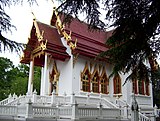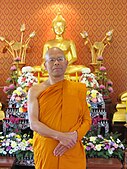|
Wat Buddhapadipa
Wat Buddhapadipa or the Buddhapadipa Temple (Thai: วัดพุทธปทีป, pronounced [wát pʰút.tʰá.pà.tʰîːp]; RTGS: Wat Phutthapathip) is a Thai Buddhist temple in Wimbledon, London. The temple is under Thai royal patronage.[1]: 28 [2]: 140 History of the templeOriginsThe temple (wat) was originally established at 99 Christchurch Road, East Sheen. The property was purchased by the Thai government for £17,000 on 24 August 1965, and the first monks took up residence on 15 November. King Bhumibol and Queen Sirikit formally opened the temple on 1 August 1966, on Āsāḷha Pūjā. King Bhumibol also gave the temple its name, which means "Light of the Buddha".[3]: 30–31 [2]: 132 [4] The desire to construct an ordination hall (ubosot) eventually meant that the temple had to be moved to a different location. In 1975, the Barrogill estate at 14 Calonne Road, Wimbledon, was purchased, and the monks moved there the following year. Situated on four acres of land, the estate had ample space for the construction of the hall.[1]: 24–25 [4][5] Ordination hallThe ordination hall was designed by the Thai architect Praves Limparangsri, and cost approximately 33 million Thai baht (£825,000). The new temple received royal consecration on 3 April 1982, and Princess Galyani Vadhana presided over the setting of the boundary stones (bai sema) around the hall on 30 October.[6]: 105 [1]: 34 [2]: 133 Inside the ordination hall are three statues of the Buddha:
AbbotPhra Thepphawanamongkhon (Thai: พระเทพภาวนามงคล) became the abbot of Wat Buddhapadipa in 1994.[7] He died in Siriraj Hospital in Bangkok on 18 November 2022, at the age of 96, after 75 rains.[8] On 30 January 2023, the Sangha Supreme Council appointed Chao Khun Laow Panyasiri as the new abbot.[9] He had been the acting abbot since 25 November 2022.[10] MuralsThe murals inside the ordination hall were painted by thirty Thai artists over an eight-year period. The two principal artists were Panya Vijinthanasarn and Chalermchai Kositpipat.[1]: 3 [note 1] They employed a contemporary style that emphasized visual impact, which was unorthodox for Buddhist imagery; the work is now considered a pivotal moment in the development of the neo-traditional style of Thai art.[11] Work began in 1984.[1]: 35 The central room was completed in 1987,[1]: 108 but the two side rooms were not finished until 1992.[1]: 171 The murals in the central room relate the life of the Buddha, and the murals in the two side rooms relate the Mahānipāta Jātaka.[1]: 75–78 Central room
Western side room
Eastern side room
Gallery
Notes
References
External linksWikimedia Commons has media related to Wat Buddhapadipa. |
||||||||||||||||||||||||||||||||||
Portal di Ensiklopedia Dunia

![Signboard [note 3]](http://upload.wikimedia.org/wikipedia/commons/thumb/7/7e/Wat_Buddhapadipa%2C_Buddhist_Temple_03.jpg/160px-Wat_Buddhapadipa%2C_Buddhist_Temple_03.jpg)



